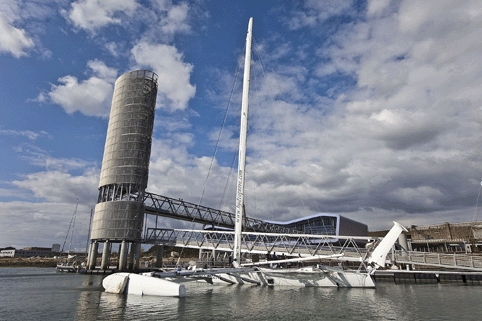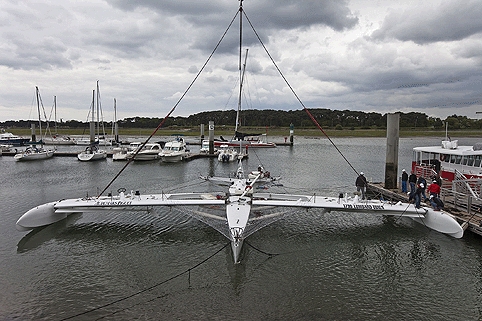Alain Thébault looked at his speedometer and watched it tick up to 31 knots. He grinned and looked beatifically towards the sky. It wasn’t the world record 50.17 knots his trimaran L’Hydroptere set last November in the French Mediterranean but it was fast enough considering the wind off the Isle of Wight coast was asthmatically puffing only a few good gusts that day. Besides even if it was rip roaring wind conditions, there was no reason to risk capsizing. Especially with a journalist on board.
It had been a dream of Thébault to skipper a flying ship ever since the day the 47-year-old French native gave up windsurfing to be a yachtsman. While L’Hydroptere never achieves any kind of surreal levitation above water, he and his engineering colleagues, who are supported by the likes of Dassault Aviation, Airbus and the Swiss Ecole Polytechnique Federale de Lausanne,designed a boat that gives passengers an almost, as Thébault puts it, ‘flying carpet’ like ride.
The take off begins for L’Hydroptere when it reaches about 12 knots. At this point the hulls of the 60ft trimaran are designed to lift out of the water simultaneously to reduce drag. The hulls ‘fly’ 5m above the surface on two fin-shaped hydrofoils, which extend at downward angles into the water from the outer stabilisers.

I watched as Thébault cheered the boat on higher and higher, faster and faster. We were on the port hull and he was behind the wheel keeling slightly to the left and right finding the sweet spot that would make the speedometer rise.
Thirty one, thirty two, thirty three knots, he clapped his hands above his head before quickly returning them to the wheel. He had to keep focused. We weren’t on open water. It was a picture perfect day off the coast of Cowes and sailboats were everywhere to be seen. Including the two right in front of us.
Thirty-three point seven, thirty four knots. I looked back at Thébault. Surely he saw those two boats ahead. It looked like we could just about squeeze between the two of them, but at such speed?
Thirty-four point five knots and now we were getting close. I could see the fear, and slight awe, in the stature of the passengers on the boat up ahead to the left of us. Compared to all the tranquil sailboats bobbing up and down around them, we were like a jet skimming the water.
Thirty-four point seven knots and whoosh. We breezed through both boats. The image of the flapping French flag attached to the back of the boat was the last their passengers had of us.
As we quickly approached the shoreline we had to prepare to make a move known in sailing as tacking, which is when you change the direction of the sailboat by bringing the bow into the wind. This is also the time when all passengers need to haul as quickly as possible over to the other side of the boat. On smaller catamaran sailboats my method for doing this is usually a variant of what you’re supposed to do if caught on fire: stop, drop and roll under the boom to the other side. This is not possible on L’Hydroptere.
First of all, it’s a trimaran, which means there is a massive hull to climb over as you scurry under the mast’s boom to get to the other side. Secondly the trampoline is net like and bouncy meaning instead of rolling you must jump across it like a kid hopping from mattress to mattress in a bedding shop. I couldn’t help put giggle every time we made our way athwart.

As we continued on our trip we were met with waves from sailors we passed. I never quite understood why people wave to you on a boat, but hey, who cares, I waved back. Some sailors just dropped their ropes and watched as we ploughed by.
The impressive engineering that went into L’Hydroptere is clear to see from miles away. I couldn’t help but stare at the mast —which stands 28m high—with my mouth agape like I was looking up at a New York City skyscraper.
The boat is made out of a large number of composite material components including 24m carbon crossbeams built by Airbus. With a clever use of carbon and titanium in the boat construction, the team were able to keep the weight at a relatively light 6.5 tonnes.
Thébault told me there is still plenty of room for innovation with sailboats. A hundred or so years ago engineers were building them out of wood, he said, now they are incorporating composites and who knows what’s next.
The exciting bit for him, though, is the journey to the next big thing. He never set out to break a world record because he never believed a sailboat could exceed 25 knots. As he told me he ‘just wanted to fly’ and he didn’t care how fast it went.
Still the record was an amazing achievement, he admits, and there is good reason it could be broken again. Thébault believes he may one day skipper a sailboat capable of travelling 70 knots or more. Somehow I don’t doubt it.










Water Sector Talent Exodus Could Cripple The Sector
Maybe if things are essential for the running of a country and we want to pay a fair price we should be running these utilities on a not for profit...